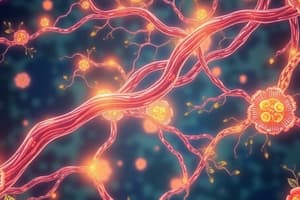Podcast
Questions and Answers
What surrounds the individual muscle fibers in skeletal muscle structure?
What surrounds the individual muscle fibers in skeletal muscle structure?
- Fascia
- Epimysium
- Endomysium (correct)
- Perimysium
Which factor does NOT contribute to force generation in skeletal muscles?
Which factor does NOT contribute to force generation in skeletal muscles?
- Blood vessel density (correct)
- Recruitment of motor units
- Frequency of stimulation
- Size of fibers
In excitation-contraction coupling, what is the first step that occurs?
In excitation-contraction coupling, what is the first step that occurs?
- An end-plate potential is generated.
- Calcium ions bind to troponin.
- Acetylcholine is released from the motor neuron. (correct)
- Action potential travels along the sarcolemma.
Which type of muscle fibers are typically associated with endurance activities?
Which type of muscle fibers are typically associated with endurance activities?
What aspect of muscle contraction is influenced by the velocity of contraction?
What aspect of muscle contraction is influenced by the velocity of contraction?
Which connective tissue layer surrounds the entire skeletal muscle?
Which connective tissue layer surrounds the entire skeletal muscle?
Which statement about muscle fiber types is incorrect?
Which statement about muscle fiber types is incorrect?
What is the role of calcium ions in muscle contraction?
What is the role of calcium ions in muscle contraction?
What initiates the release of acetylcholine (ACh) at the axon terminal?
What initiates the release of acetylcholine (ACh) at the axon terminal?
What is the primary pathway for ATP synthesis in Type I muscle fibers?
What is the primary pathway for ATP synthesis in Type I muscle fibers?
Which factor does NOT affect skeletal muscle force production?
Which factor does NOT affect skeletal muscle force production?
Which muscle fiber type is characterized as fast glycolytic?
Which muscle fiber type is characterized as fast glycolytic?
In the excitation-contraction coupling process, what triggers the release of calcium ions (Ca2+) from the sarcoplasmic reticulum?
In the excitation-contraction coupling process, what triggers the release of calcium ions (Ca2+) from the sarcoplasmic reticulum?
Which factor is NOT a part of the neuromuscular contributions to muscle force production?
Which factor is NOT a part of the neuromuscular contributions to muscle force production?
Which muscle fiber type has the largest motor neuron size?
Which muscle fiber type has the largest motor neuron size?
What is the fate of acetylcholine (ACh) after it has activated the motor end plate receptors?
What is the fate of acetylcholine (ACh) after it has activated the motor end plate receptors?
What initiates the contraction cycle in skeletal muscle fibers?
What initiates the contraction cycle in skeletal muscle fibers?
During the contraction of muscle fibers, what role does Ca2+ play?
During the contraction of muscle fibers, what role does Ca2+ play?
What happens when tropomyosin blocks myosin-binding sites?
What happens when tropomyosin blocks myosin-binding sites?
What is the sequence of events that occurs after the action potential reaches the sarcolemma?
What is the sequence of events that occurs after the action potential reaches the sarcolemma?
What is the function of the sarcoplasmic reticulum in muscle contraction?
What is the function of the sarcoplasmic reticulum in muscle contraction?
Which structure directly transmits the action potential into the muscle fiber?
Which structure directly transmits the action potential into the muscle fiber?
What event directly follows the binding of Ca2+ to troponin during muscle contraction?
What event directly follows the binding of Ca2+ to troponin during muscle contraction?
Which of the following describes the role of acetylcholine (ACh) in muscle contraction?
Which of the following describes the role of acetylcholine (ACh) in muscle contraction?
What results from the active transport of Ca2+ back into the sarcoplasmic reticulum?
What results from the active transport of Ca2+ back into the sarcoplasmic reticulum?
Which stage comes first in the process of excitation-contraction coupling?
Which stage comes first in the process of excitation-contraction coupling?
Flashcards are hidden until you start studying
Study Notes
Muscle Fibre Types
- Type I (Slow Oxidative): Slow contraction speed, aerobic ATP synthesis, high resistance to fatigue, small motor neuron, recruited first, low force production, suited for endurance activities like marathon running and posture maintenance.
- Type IIA (Fast Oxidative): Moderately fast contraction speed, aerobic (some anaerobic) ATP synthesis, fairly high resistance to fatigue, medium motor neuron, recruited second, medium force production, suited for activities like sprinting and walking.
- Type IIB (Fast Glycolytic): Fast contraction speed, anaerobic ATP synthesis, low resistance to fatigue, large motor neuron, recruited third, high force production, suited for activities requiring quick, powerful movements like hitting a baseball.
Factors Affecting Skeletal Muscle Force Production
- Anatomical Factors:
- Gross Muscle Structure: Muscle size, shape, and arrangement of fascicles influence force production (biomechanics and movement analysis).
- Fibre Types: The proportion of different fibre types determines the muscle's functional characteristics (e.g., endurance vs. power).
- Number of Fibres: More fibres mean greater potential force production.
- Size of Fibres: Larger fibres produce more force.
- Neurological Factors:
- Frequency of Stimulation: More frequent stimulation increases force production.
- Recruitment of Motor Units: Increasing the number of activated motor units increases force production (size principle).
- Functional Factors:
- Muscle Length: Muscles generate maximal force at optimal length.
- Velocity of Contraction: Force production decreases as contraction velocity increases.
Studying That Suits You
Use AI to generate personalized quizzes and flashcards to suit your learning preferences.




